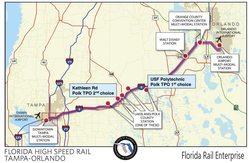User:Aalox/HSR

Florida High Speed Rail is a proposed high-speed rail network in Florida. President Obama announced $1.25B in funds to construct the Orlando-to-Tampa route of this project on January 28, 2010.[1]
Original referendum
[edit]The system was originally authorized by a 2000 referendum of Florida voters but repealed by 64% of Florida voters in a 2004 referendum. The first phase, planned for completion in 2009 under the original referendum, would have connected Orlando to Tampa (Phase 1 Part 1), with a later extension to St. Petersburg (Phase 1 Part 2). Later phases might have extended the network to Miami, Fort Myers, Jacksonville, Tallahassee and Pensacola.
Some have argued that the wording on the 2004 referendum was misleading, and some may have assumed it was the same as the 2000 referendum and voted the opposite of what they meant to vote.[citation needed]
Despite the denial of funding due to the referendum passed November 2, 2004, the Florida High Speed Rail Authority continues to meet, and is almost done with the environmental impact statement for the Tampa-Orlando segment. In January 2007 the authority issued an update letter to the Florida governor.
On October 27, 2004, the authority voted to prefer the consortium of Fluor Corp. and Bombardier Transportation to build and operate the system, using Bombardier's JetTrain technology.
Plans revived in 2009
[edit]Very little action was taken following the authority's vote on preferred equipment until 2009, when the American Recovery and Reinvestment Act of 2009 designated $8 billion for the development of a high-speed intercity passenger rail system. The Federal Railroad Administration named FHSR (under the designation "Florida Corridor") among ten corridors given top priority. [1] The Florida State House and Senate both pass legislation to fund rail in Florida on December 8, 2009.
The revival of high speed rail in Florida is championed by the political action committee Connect Us, Inc..[2]
American Recovery and Reinvestment Act of 2009
[edit]On January 28, 2010, the White House announced in Tampa that Florida would receive $1.25 Billion of its request.[3]
Tampa to Orlando route
[edit]Planned Orlando -Tampa Route | |||||||||||||||||||||||||||||||||||||||||||||||||||||||||||||||||||||||||||||||||||||||||||||||||||||||||||||||||||||||||||||||||||||
|---|---|---|---|---|---|---|---|---|---|---|---|---|---|---|---|---|---|---|---|---|---|---|---|---|---|---|---|---|---|---|---|---|---|---|---|---|---|---|---|---|---|---|---|---|---|---|---|---|---|---|---|---|---|---|---|---|---|---|---|---|---|---|---|---|---|---|---|---|---|---|---|---|---|---|---|---|---|---|---|---|---|---|---|---|---|---|---|---|---|---|---|---|---|---|---|---|---|---|---|---|---|---|---|---|---|---|---|---|---|---|---|---|---|---|---|---|---|---|---|---|---|---|---|---|---|---|---|---|---|---|---|---|---|
| |||||||||||||||||||||||||||||||||||||||||||||||||||||||||||||||||||||||||||||||||||||||||||||||||||||||||||||||||||||||||||||||||||||
 | |||||||||||||||||||||||||||||||||||||||||||||||||||||||||||||||||||||||||||||||||||||||||||||||||||||||||||||||||||||||||||||||||||||
In early planning stages, all routes but the one along the median of Interstate 4 (which has been and is being widened by several road construction projects) were dropped from consideration; alternates used the CSX tracks to the south of I-4. Stations would be provided at downtown Tampa, northern Lakeland, Walt Disney World, possibly at the Orange County Convention Center (see below), and at Orlando International Airport. Lynx's #50 bus, which runs mostly express along I-4 from Walt Disney World to downtown Orlando, would likely be rerouted to serve the Disney station, which would be built on the northwest side of I-4 between US 192 and the Osceola Parkway.
Orlando route selection
[edit]Two routes were considered in the Orlando area. One would have split from I-4 at the SR 536 interchange, and run east along SR 536 and SR 417 to the south entrance to Orlando International Airport, from which it would head north to end at the planned South Terminal. The other route would continue along I-4 to SR 528, with an extra stop at the Orange County Convention Center and International Drive, and then run east along SR 528 and a new right-of-way east and southeast to the south entrance of the airport.
The SR 417 route (Greeneway Route) was selected by a 7-1 vote on October 27, 2004. In 2009, Disney donated a large amount of land for a station, and agreed to support stops at the Orlando Orange County Convention Center using the SR 528 route.
Advantages of the SR 417 route
[edit]- The Walt Disney Company initally announced that if the SR 417 route was built, they would direct tourists to take the train from the airport to Walt Disney World. However, since they wanted to deny competitors on International Drive a station, they would keep busing tourists if the SR 528 route was built. Disney later backed off of this demand, and gave their full support to the SR 528 route.
- It would leave room for a planned light rail system along I-4 from Walt Disney World to downtown Orlando.
- It would be shorter and thus faster.
Advantages of the SR 528 route
[edit]The Florida High Speed Rail Authority’s Vision Plan anticipates that the statewide system will be constructed in phases. At this time, the Authority has completed the Final Environmental Impact Statement for the Tampa to Orlando Project Segment, and the next step will be issuance of a Record of Decision by the Federal Railroad Administration.
The Florida High Speed Rail Authority's long-term vision calls for a statewide high speed rail system to reduce traffic congestion and provide alternatives to the traveling public. The system would closely parallel existing highways and connect Florida communities, cities, airports and seaports throughout five major regions of the state. This map shows possible routes through key cities in Florida.
- An extra stop would in theory mean more ridership.
- Non-Disney area attractions would be served better.
See also
[edit]References
[edit]External links
[edit]- Florida High Speed Rail
- Florida Corridor section of the Federal Railroad Administration website
